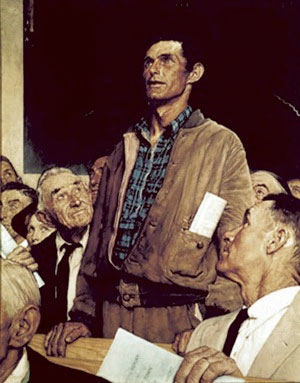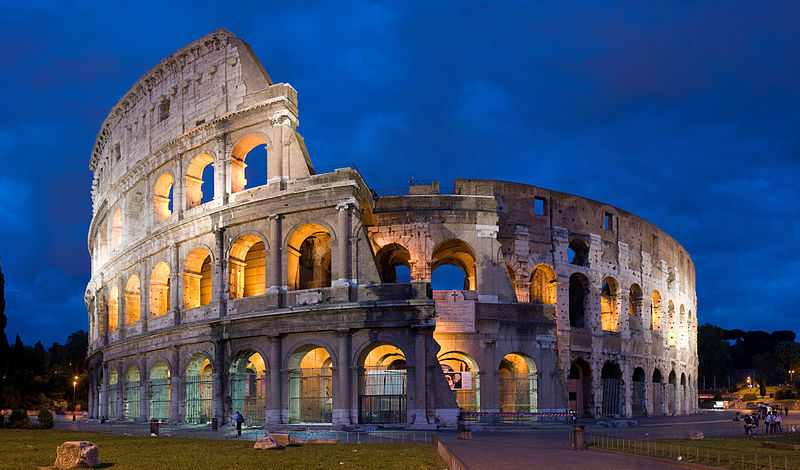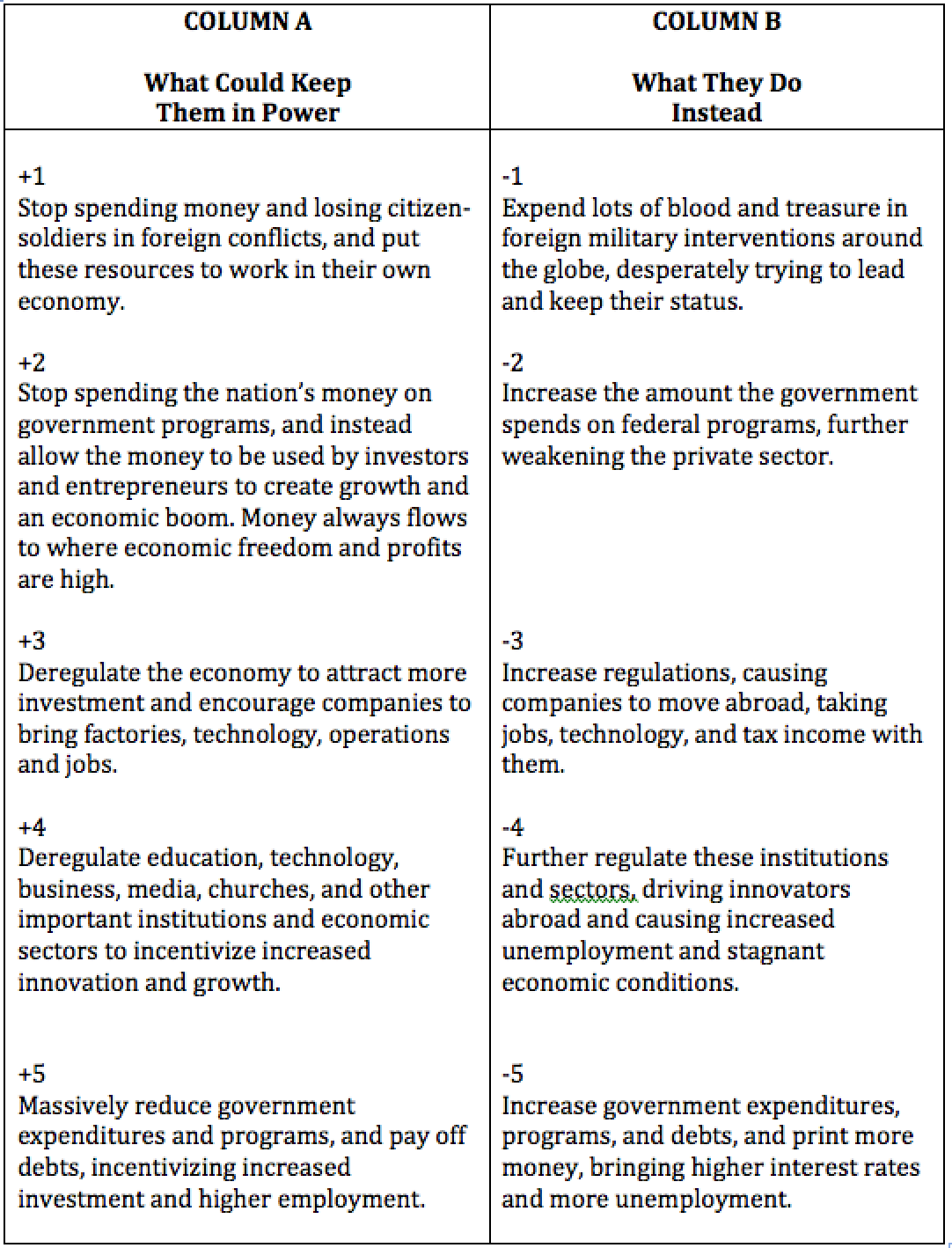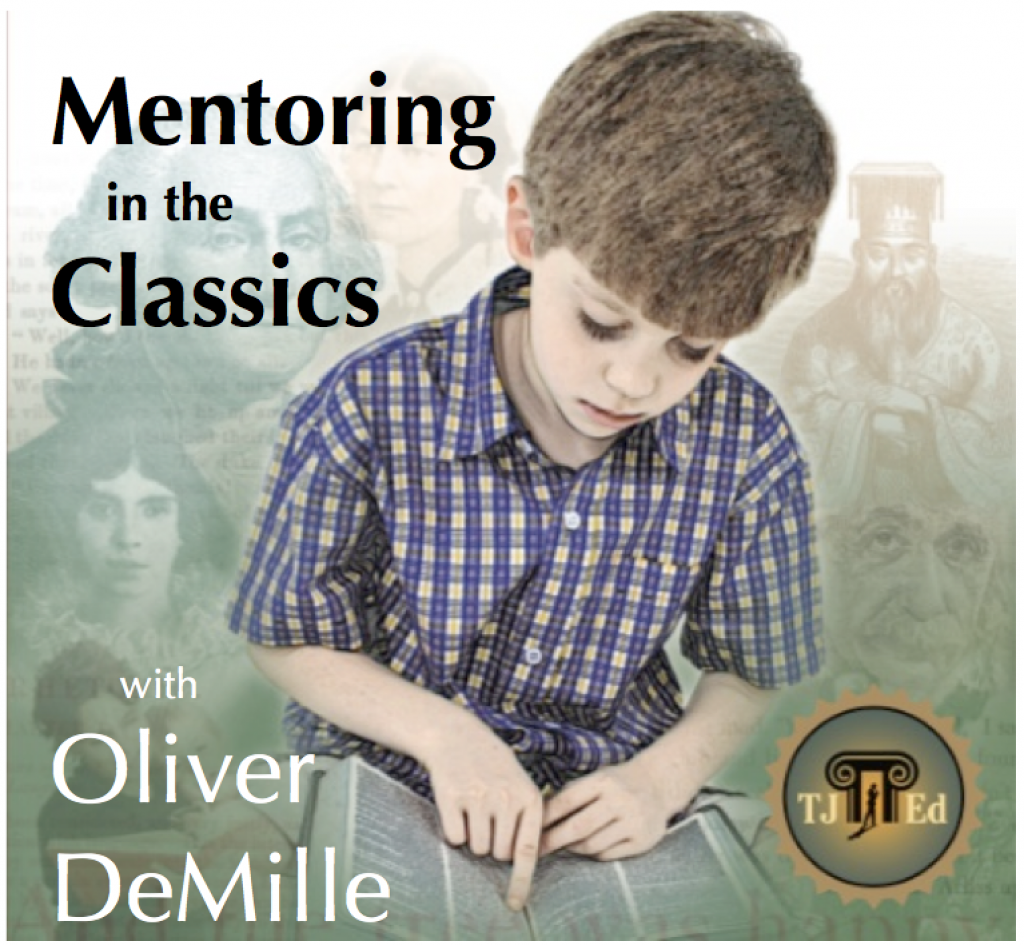The Fall of Institutionalism by Oliver DeMille
March 13th, 2015 // 11:02 am @ Oliver DeMille
A Major Change in America
 We have a trust crisis in America. Specifically, we don’t trust our major institutions. For example, consider the current American view of government. A Gallup poll asked, “How much of the time do you think you can trust government in Washington to do what is right?”
We have a trust crisis in America. Specifically, we don’t trust our major institutions. For example, consider the current American view of government. A Gallup poll asked, “How much of the time do you think you can trust government in Washington to do what is right?”
The response? Only 19% of Americans highly trust government “most of the time.” And, a full 81% don’t trust the government to do the right thing most of the time. That’s huge.
In a 2013 Pew Research Center Poll, 53% of Americans said that the federal government “threatens their personal rights and freedoms.” In fact, for the most part, the more educated people are, the less they believe “Washington will do the right thing most of the time.”
When asked “which of the following will be the biggest threat to the country in the future: big business, big labor, or big government?,” only 26% said big business while 64% said big government. And 83% of Americans said they are “dissatisfied” with “the way the nation is being governed.”
But is doesn’t stop with Washington.
Trust and Angles
Only 25% of Americans have high “trust in the police,” the same amount as those who have great trust in churches/organized religion. A mere 17% have high trust in the medical system, and even less, 12%, have such trust in the public schools. The percentage with high trust in the banks is 10. As important as these institutions are in modern American life, these numbers are dismal.
This lack of significant trust reflects a major shift in American views. For example, consider the following comparison of institutional trust in 2014 versus 1975 (Op Cit.):
| INSTITUTION | % OF AMERICANS WITH HIGH TRUST IN 1975 | % OF AMERICANS WITH HIGH TRUST IN 2014 |
| Public Schools | 29 | 12 |
| Congress | 14 | 4 |
| The Presidency | 23 | 14 |
| The Medical System | 44 | 17 |
| The Supreme Court | 20 | 12 |
| Church/Organized Religion | 43 | 25 |
Looking at this from another angle, only 19% of Americans really trust the federal government and only 19% have high trust in their state government. In other words, we see our state governments in the same negative light as Washington. And only 25% of Americans have high trust in their local governments.
If modern Americans don’t feel that they can trust their local or state governments, schools, the media, banks, Wall Street, the justice system, the police, the courts, Congress, the White House, the Internet, doctors, or churches—who can they trust?
The Status of an Era
As a 2015 TV Guide article put it: “A 2014 Harvard University poll revealed that only 11 percent of Millennials [those born between 1984 and 2001] trust the media to do the right thing most of the time.” And only 8% of Americans have high trust in the news they read on the Internet.
One area of more positive support: When asked to rate certain institutions as “positive” or “negative”, 95% of Americans ranked small business as positive and only 49% said big business was positive. The federal government was ranked positive by 46%, and “Entrepreneurs” by 84%.
In short, most people trust small businesses more than any other institution listed above, more than their local, state, or federal government or any branch of government, and more than the media, health care, public schools, banks, newspapers, the Internet, or churches.
What does this mean for our future? Can we solve our major national problems or overcome serious challenges without strong bonds of societal trust?
And, in fact, do such levels of distrust actually fuel additional problems? Is the mistrust itself a cause of deeper struggles? Meaning: will every difficulty quickly spin into crisis, simply because the level of suspicion and cynicism won’t allow us to come together and work toward constructive solutions? This isn’t just a Washington problem, it’s a true societal problem.
One thing is certain: the era of major trust in big institutions is clearly over.
Category : Blog &Citizenship &Community &Culture &Current Events &Government &History &Leadership &Politics
How Freedom Might Win in 2016
February 14th, 2015 // 8:18 pm @ Oliver DeMille
The New Field
 I was wrong. I thought Mitt Romney would run in 2016, but he declined. Where does this leave the election? More importantly, with a large field of potential candidates, is there a path for freedom? Meaning, can someone like Rand Paul who really believes in applying the Constitution in our modern times actually win?
I was wrong. I thought Mitt Romney would run in 2016, but he declined. Where does this leave the election? More importantly, with a large field of potential candidates, is there a path for freedom? Meaning, can someone like Rand Paul who really believes in applying the Constitution in our modern times actually win?
The definite answer is “maybe.” But, more than any election since at least the 1980s, there is a narrow chance of this happening in 2016.
To explore this, we need to clearly understand two important points.
Charisma and Coolidge
First, in every presidential general election the most likeable candidate wins. Always. And in presidential politics “likeable” means both “fun, cool, engaging” and also that a majority of voters believe the candidate really cares about them.
This reality isn’t negotiable. The U.S. electorate always chooses the most likeable candidate for president. So if a Republican candidate isn’t more likeable to the general electorate than Hillary Clinton, he or she won’t win.
Second, there are two major groups of Republicans running for the White House: Establishment Republicans and Serious Freedom-Lovers. It’s been over thirty years since a Serious Freedom-Lover won the presidency. Since 1988, Republican nominees have been a long list of Establishment Rep’s: Bush I, Dole, Bush II, McCain, Romney. And before Ronald Reagan, Republican presidents were all Establishment Rep’s through Ford, Nixon, Eisenhower, and all the way back to Freedom-Lover Calvin Coolidge in the 1920s.
In the 2016 Republican primaries, Establishment votes will naturally split between candidates such as Jeb Bush, Chris Christie, and John Kasich.
Likewise, Freedom-Lover votes will be divided between people like Ted Cruz, Rand Paul, Mike Huckabee, Ben Carson, etc. And a few potential candidates might appeal to both sides, like Scott Walker, Marco Rubio, and Carly Fiorina.
Where the Votes Sit
So what does this all mean for the Republican primaries as they select a nominee to face Hillary Clinton in the general election? While it’s still early, a few things are becoming increasingly clear:
- The Establishment Rep’s will tend to centralize their support behind one of the following: Jeb Bush, or perhaps Chris Christie, John Kasich, Scott Walker, or Marco Rubio. It is most likely Bush’s to lose, or Kasich’s, Rubio’s, or Walker’s to win.
- The Freedom-Lover wing of the GOP will most likely split between various candidates, not concentrating strong support for any one person.
- But the only path to victory by a Serious Freedom-Lover is for voters in this wing of the party to centralize support behind one or at the most two candidates.
Currently, based on the polls, Republicans with a reasonable chance of becoming president are Bush, Rubio, Christie, Paul, and Walker. Let’s compare how each of these do on likeability in the general election:
| Candidate | Youth | Independents | Latinos | Swing State Voters | Overall GeneralElection Likeability |
| Bush | Weak | Medium | Strong | Medium | Medium |
| Christie | Medium | Weak | Weak | Medium | Weak |
| Paul | Strong | Strong | Medium | Strong | Strong |
| Rubio | Strong | Medium | Strong | Strong | Strong |
| Walker | Weak | Medium | Weak | Medium | Medium |
These can, of course, change as the election unfolds. But the problem for Republicans, as it has been since 1992, is that the factors that make a candidate strong in the GOP primaries are very different than those that make them strong in the general election. Compare:
| Candidate | Likeability in Most GOP Caucuses and Primaries | Likeability in General Election |
| Bush | Strong | Medium |
| Christie | Strong | Weak |
| Paul | Medium | Strong |
| Rubio | Medium | Strong |
| Walker | Strong | Medium |
Chains…and Weak Links
In other words, the Republicans have a structural problem. They look for different things in selecting a nominee than the general electorate looks for in choosing the president. Using this system, candidates who are Strong in the GOP primaries are usually Weak or Medium in the generals, while candidates who are Strong in the generals are Medium or Weak in the GOP primaries.
In contrast, the Democrats look for the same things in the primaries that the voters look for in the generals. This is a significant advantage for the Democrats. If Hillary Clinton were added to the chart above, for example, and the heading were changed to “Electability in the Democratic Primaries,” she would rate Strong in both the primaries and the general election. Elizabeth Warren would rate Strong in both as well. Joe Biden would rank Medium in the primaries and Weak in the general—which is why Democrats won’t make him their nominee.
In 2008 Barack Obama rated Strong in both, while McCain (in normal Republican fashion) was Medium in the primaries and Weak in the generals. Romney in 2012 ranked Medium in the primaries and Weak in the general among women, youth, swing state voters, independents and Latinos.
2016 could prove unique because two of the top five potential Republican nominees rank Strong in general election likeability. This is especially significant because they are both strong in the Serious Freedom-Lover camp. But winning the nomination will certainly be an uphill battle for them.
 Oliver DeMille is the New York Times, Wall Street Journal and USA Today bestselling co-author of LeaderShift: A Call for Americans to Finally Stand Up and Lead, the co-founder of the Center for Social Leadership, and a co-creator of TJEd.
Oliver DeMille is the New York Times, Wall Street Journal and USA Today bestselling co-author of LeaderShift: A Call for Americans to Finally Stand Up and Lead, the co-founder of the Center for Social Leadership, and a co-creator of TJEd.
Among many other works, he is the author of A Thomas Jefferson Education: Teaching a Generation of Leaders for the 21st Century, The Coming Aristocracy, and FreedomShift: 3 Choices to Reclaim America’s Destiny.
Oliver is dedicated to promoting freedom through leadership education. He and his wife Rachel are raising their eight children in Cedar City, Utah.
Category : Aristocracy &Blog &Citizenship &Community &Constitution &Culture &Current Events &Featured &Generations &Government &History &Independents &Leadership &Liberty &Politics &Statesmanship
President Obama’s Free College Tuition Plan
January 30th, 2015 // 5:42 pm @ Oliver DeMille
Some (Widespread) False Traditions about College, Grades, and Career
A Good Plan?
 President Obama proposes making two years of community college free for everyone. As The New York Times reported (“Expanding Community College Access”), the Administration’s “preliminary plans…call for an estimated $60 billion in new spending over ten years…” That’s right. Just throw more money at it and things will get better, right?
President Obama proposes making two years of community college free for everyone. As The New York Times reported (“Expanding Community College Access”), the Administration’s “preliminary plans…call for an estimated $60 billion in new spending over ten years…” That’s right. Just throw more money at it and things will get better, right?
Actually, no. What if, instead, we didn’t raise taxes $60 billion for the program (plus the extra funds necessary to administer it) and left these resources in the hands of the private economy?
This gets to the crux of one of our deepest and most pressing problems today. When we see a need in society—almost any need, it turns out—someone proposes a government program. The costs of such programs, and the regulations of implementing them, make our economy less inviting for investors and innovators. Naturally, jobs, capital, and opportunities go to other nations.
The result? The economy struggles even more. And, behold, a politician in Washington takes note of the increased struggles and suggests yet another economy-killing government program.
This downward cycle is literally fueling our national decline. These types of government programs have had real results: Where one wage earner in a household made enough for the family to live on in the 1950s, today it takes two wage earners plus a steadily increasing amount of debt for households to pay for a lesser standard of living.
Cause and Effect
Such government programs are touted as real benefits, but the more of them we implement in society, the wider the gap grows between the rich and the rest.
If this new community college program is adopted, the results are predictable:
- The quality of community college education will decrease (just as high schools did when government made them free and ubiquitous)
- More community colleges will be built (requiring tax increases)
- Fewer educational entrepreneurs will offer true educational innovations
- More people will get two years of college
- Two years of college will become much less beneficial
- More young adults will live in their parent’s basement—for longer
- S. citizens will lose more jobs to international competitors
- The U.S. standard of living will further decline
- There will be a few good community colleges, and a lot more poor ones, and national leaders will talk incessantly about “solving the community college crisis”
- The quality of education in most high schools (not just community colleges) will further decrease
“But how can you say these things?” the proponents of the new program will ask. “More jobs today require some college education, so how can free community college be anything but a great plan?”
Actually, more jobs require a higher level of education. But calling it “college education” is just labeling. The level and quality of education students received in four years of high school in 1930 or 1953 was higher than nearly all college juniors have today.
Why did high school education decline? Mostly because of the many government programs that got in the way of market forces and educational quality.
So why are we proposing more of them? We shouldn’t be.
Part II: The Real Issue
But let’s go deeper into college education. Specifically, let’s deal with the real issue. The true concern. It is right in front of us, but only a few people are talking about it. This is vitally important.
Sometimes our most common beliefs in society turn out to be wrong, or at least different from the reality. For example, a lot of young people today are told that the key to a successful life is a good career, and the way to ensure a good career is getting into a good college, picking the right major, and getting good grades.
Many high school and even elementary students busily study each night to prepare for the SATs and such life success—based on this oft-repeated promise. They spend years sure that good grades will lead to promotions, wealth and status.
But the truth is often very different. A report from the Chronicle of Higher Education showed the reality of what employers look for when hiring:
- “Health care companies care most about your major”
- “White-collar companies care the most about your GPA”
- “Media and communication companies are gaga for internships and…indifferent toward your classes”
- “Ironically, education employers care the least about grades” (quotations from Derek Thompson, “The Thing Employers Look For When Hiring Recent Graduates,” The Atlantic)
This is not what most young people are told—by teachers, school administrators, academic counselors, even parents. How can they make good career-prep choices when most of what they are told about the relationship between schooling and career success is inaccurate or at best incomplete?
The Scale
I’ve long taught that schooling should focus on great education, not the growing trend of “hire education,” but this view is in the minority. Many people believe the main purpose of education is career prep, and students are often frustrated when the reality turns out to be something different.
In an economy where many graduates are already without jobs, these false traditions (e.g. “the key to a successful life is a good career, and that comes from attending a prestigious college, picking the right major, and getting good grades”) take on increased importance. Many young people believe in these ideas as promises, not urban myths.
The Chronicle of Higher Education report showed the following (ibid.):
- On a scale of 1 to 100, the importance of your college’s reputation to prospective employers is 5.
Not 85. Not 55. Not 50. Not even 15. Just 5. How can 5 out of 100 be worth all the focus people give it?
- Using the same scale, the importance of your GPA is 8.
That’s right, 8. All the work, the effort, the tears and struggles to get top grades, and they’re only an 8 to employers? Not 8 out of 10, mind you, but 8 out of 100! As top students know, the difference in work and effort required between A- and A is about the same as between C and A-. So, it’s no surprise that students are stunned to learn how little employers actually think or care about grades.
- Even your college Major only scores 13 on this scale.
But it gets worse. This score of 13 is actually driven up by the health care industry. If your career is in health care, it’s quite a bit higher, but if you’re in a different industry, it’s much lower.
In short, for most people, the gatekeepers that bring you in to (or keep you out of) a great career don’t care about what school you went to, your GPA, or your major.
The Forgotten “Why”
So what do prospective employers look at? Again, according to the Chronicle report:
- The number one thing is internships.
- Number two is employment experience.
Really? Then why are so many young people counseled to avoid work and put all their time into getting good grades? And why are they told to put most of their efforts into admittance to the most prestigious schools?
The focus should be on internships and work experience. Amazing.
This is a major departure from what most educators tell their students. It’s very interesting, and something any parent should consider.
It also brings me back to my original view. Use schooling, reading, and other learning to get a great, truly excellent education. That’s why schools were invented, after all. The rest is, literally, minor. The research now proves it.
The Real Solution
The solution—unless you work in the health care field—isn’t two more years of government-funded schooling, but better education in the years before college. Followed by the same increased quality during college, or even instead of college. We don’t need more mediocre schooling—we need a drastic improvement in what we already have. Seriously.
Get a great education before you turn 18 by reading, studying, digging into the classics, etc.—and then continue it in college or working directly with great mentors instead of college—and don’t let 5%, 8%, and <13% things like the “right” school, GPA, and the “right” major determine (or get in the way of) your education.
And, along the way, get some great experiences with internships and work experiences. Include a number of important classics in your reading. This will bump your whole education to a higher level, and with a better education and better experiences, your career options will only improve.
This is the real solution, regardless of whether or not the government adopts some costly new education program that won’t help very much and will in fact send a lot more capital, innovation, and jobs abroad. The program will only make things harder—for education, and for the economy.
Washington, please keep this plan to yourself. Literally: Put your kids through it if you want. Leave the rest of the economy alone.
Oh, and parents, pass this along to young people. A great education will greatly boost your career prospects, and for most careers a great education is not the same thing as your college, major, or GPA. Not at all. Whatever you do about these things, do what it takes to get a great education.
 Oliver DeMille is the New York Times, Wall Street Journal and USA Today bestselling co-author of LeaderShift: A Call for Americans to Finally Stand Up and Lead, the co-founder of the Center for Social Leadership, and a co-creator of TJEd.
Oliver DeMille is the New York Times, Wall Street Journal and USA Today bestselling co-author of LeaderShift: A Call for Americans to Finally Stand Up and Lead, the co-founder of the Center for Social Leadership, and a co-creator of TJEd.
Among many other works, he is the author of A Thomas Jefferson Education: Teaching a Generation of Leaders for the 21st Century, The Coming Aristocracy, and FreedomShift: 3 Choices to Reclaim America’s Destiny.
Oliver is dedicated to promoting freedom through leadership education. He and his wife Rachel are raising their eight children in Cedar City, Utah.
Category : Blog &Citizenship &Community &Current Events &Education &Entrepreneurship &Featured &Generations &Government &History &Leadership &Liberty
The Main Source of the American Decline
January 23rd, 2015 // 7:04 am @ Oliver DeMille
Land of the Free Land of Decay
 These days, the word “decline” is frequently used to describe the United States. Where “China” is often paired with words and phrases like “rising,” “new superpower,” and “number one,” a different set of adjectives show up when the U.S. is discussed.
These days, the word “decline” is frequently used to describe the United States. Where “China” is often paired with words and phrases like “rising,” “new superpower,” and “number one,” a different set of adjectives show up when the U.S. is discussed.
This trend recently reached a new low when the cover story on Foreign Affairs was entitled, “See America: Land of Decay and Dysfunction.”
Wow! And we thought “decline” was bad. But decay? And dysfunction? That’s hitting below the belt.
It gets even more interesting, however.
The Players and The Played
The article goes on to suggest that the cause of this “decay” and “dysfunction” is the power of various special interest groups. This is a popular argument, mainly because almost everyone loves to blame special interest groups.
But this proposition bears scrutiny. Indeed, if special interest groups really are the reason for America getting off track, it is one of the most important topics of our time.
In reality, however, something else is at play here. Yes, of course, special interest groups are a serious problem to the precise extent that they “control” government. But why do they control our government? Who allows this? It certainly isn’t written in the Constitution.
Francis Fukuyama, who wrote the Foreign Affairs article, notes that the classic book The Semisovereign People gets to the heart of our challenge. In short, voters are highly swayed by the two big political parties, by the media, and by special interest groups. Special interest groups “control” Washington because they set out to control the parties and the media.
The Madisonian idea of sovereignty in the people (that the voters have the final say in who their leaders are, and what their leaders can and can’t do) is undermined when voters are easily swayed. Period.
Semisovereignty—where the voters do what special interests convince them to do through the media and political parties—is an entirely different political arrangement. It is more like an aristocratic, elite, oligarchy than a democratic republic.
That’s where we are today. And, in according to this analysis, it is the source—not merely a source, but the root—of our decline, decay, and dysfunction. The voters, in this view, don’t know better than to vote as they are told by the interest groups, parties, and media.
This causes them to mistrust government, vote against higher taxes, and remain frustrated with Washington—no matter what it does. The touted “solution?” Be more like a European parliamentary system.
Sadly, too many people are buying in to this flawed narrative.
The problem with this entire analysis is that it is partially true, but not actually true. Meaning what?
Let’s get specific: The fundamental reason for decline, decay, and dysfunction is not a lack voter influence, but rather the exact opposite. American voters—the majority, at least—want more government services than they want to pay for. They want other people to pay for them.
Where We Build From
 They want their government services, and they want them on Henry the Fifth terms. In other words, the typical American voter (let’s call him Tom) wants Washington to cut other peoples’ government programs—but none that directly benefit Tom or his family. That’s the crux of our decline and decay. Pure and simple.
They want their government services, and they want them on Henry the Fifth terms. In other words, the typical American voter (let’s call him Tom) wants Washington to cut other peoples’ government programs—but none that directly benefit Tom or his family. That’s the crux of our decline and decay. Pure and simple.
Tom votes for the candidate promising that Tom’s favorite government programs will be protected while Alice’s “socialistic” programs will be cut. Alice, in turn, votes for the candidate who supports her “essential” government benefits while promising to cut Tom’s “greedy” or “imperialistic” programs.
Political parties, special interest groups, and media only dominate American politics because Tom and Alice—and a majority of other voters—take this approach. And our decline is assured if the cost of our government programs continues to depend primarily on debt.
Until Tom and Alice, or a majority of voters are willing to elect candidates who will end our debt-dependence and spend within our means (however hard the choices), the parties, lobbies, and media outlets will continue to sway the vote.
Don’t let the media, or anyone else, fool you. We are in decline because the electorate refuses to make the hard choice of fiscal and moral responsibility. Until we do, we’ll be a nation based fundamentally on debt—not principle.
Such a nation is…always…a nation in decline, decay, and dysfunction.
For solutions, see Oliver’s new book: The U.S. Constitution and the 196 Indispensable Principles of Freedom
 Oliver DeMille is the New York Times, Wall Street Journal and USA Today bestselling co-author of LeaderShift: A Call for Americans to Finally Stand Up and Lead, the co-founder of the Center for Social Leadership, and a co-creator of TJEd.
Oliver DeMille is the New York Times, Wall Street Journal and USA Today bestselling co-author of LeaderShift: A Call for Americans to Finally Stand Up and Lead, the co-founder of the Center for Social Leadership, and a co-creator of TJEd.
Among many other works, he is the author of A Thomas Jefferson Education: Teaching a Generation of Leaders for the 21st Century, The Coming Aristocracy, and FreedomShift: 3 Choices to Reclaim America’s Destiny.
Oliver is dedicated to promoting freedom through leadership education. He and his wife Rachel are raising their eight children in Cedar City, Utah.
Category : Blog &Citizenship &Community &Constitution &Culture &Current Events &Economics &Education &Featured &Foreign Affairs &Generations &Government &History &Leadership &Liberty &Mission &Politics &Statesmanship
America’s Looming Crash: Special Report Parts I, II, III
January 9th, 2015 // 7:56 am @ Oliver DeMille
I am an optimist. I believe the best of America and the world are still ahead. But we’re only going to get there by dealing with the reality that the United States is now in an era of significant decline. Specifically, at least two things happened this year that are major problems, and a third serious problem is gaining increased support among many world leaders.
Part I
 First, our federal debt went over the $18 trillion mark in 2014. Someone is going to have to pay this back, and that means we’ll be paying for it for the rest of our lives—and so will our children and grandchildren.
First, our federal debt went over the $18 trillion mark in 2014. Someone is going to have to pay this back, and that means we’ll be paying for it for the rest of our lives—and so will our children and grandchildren.
That’s approximately $58,065 for every man, woman, and child currently in the United States. If you have a family of four, you now owe around $232,260. This debt must be paid in addition to whatever other taxes are needed for national security, services, and all other government programs now and going forward–not to mention your family’s living expenses.
To be more realistic, the truth is that many people will never pay any taxes toward this amount—because they won’t make enough. This means you’re likely to end up being charged at least twice this amount. Some people will pay a lot more. So you really owe more like $116,130 or $464,520 for your family of four.
If you have big family, say of ten people, you owe roughly $2 million dollars over the course of the rest of your life. Whatever you don’t pay off, the government will charge your kids and grandkids.
Oh, and you need to add to that all the interest still to be charged on this amount, which means that you actually owe between $1.8 million if you have a family of four, or up to around $7 million if your family is bigger. And, yes, if interest rates on the national debt increase (all the trends indicated they will), this amount will go up rapidly.
Most people have no idea what a big deal this is. This is money that has already been spent. It’s owed. And we have to pay it, now and later. We, our kids, and their kids too.
Problems and Booms
How big is this? Multiply your salary by the number of years you have left working (x), and then multiply at least $116,130 by the number of years you have to live (y). If you make more than $60,000 a year, double both amounts. If you make more than $100,000 a year, quadruple both. Then subtract one from the other to find if you’ll make more than you already owe the government.
Too much math? That’s exactly what the government is banking on. The government only gets away with this level of borrowing and spending because very few people do the math or understand what it means to them personally. Granted, these numbers are very basic, and the reality is actually worse, given interest and rising interest rates on the national debt.
So, the United States has a problem. It has a number of problems, actually, but this one is massive. The government owes so much that our economy will struggle under the weight of this debt for the rest of the century. It will dampen every citizen’s opportunities, block every generation’s choices, and haunt our posterity for many decades.
Is there any way out of this? Yes. The answer is simple, in fact. We need a major economic boom. A massive boom would allow us to pay this off much quicker and put the nation back on positive economic footing. Without such a boom, this problem is going to deepen.
How do we get a boom? Again, the answer is simple. I’ll outline it below in Column A.
But first, what happens if we don’t make the choices that will bring a boom? The answer is clear. And drastic. Our economics will rapidly get worse. For the nation, for families, for almost everyone.
Part II
Second, China just surpassed the United States as the top producing economy in the world. It was already the top trade economy, as of a year ago. How does this translate into real life consequences for real people? Well, such a transition has happened before, and there is a predictable pattern that occurs when a new nation becomes the largest global economy.
Here is a rough outline of this pattern:
- The new power (e.g. China) has the ability to dictate its own trade rules, which increases the flow of wealth to it—and away from the old power (e.g. the U.S.).
- The new power’s currency eventually becomes the lead world currency (replacing the old power’s currency). When Britain lost it’s top power spot, the average British citizen lost 30% of net worth within weeks. In the current shift, the Chinese will likely push for a global currency. (More on this in Part III)
- The old power keeps trying to regain its status by engaging in wars and military interventions around the globe, while the new power focuses mainly on economic success. This further weakens the old power, and quickly.
- The new power, with its booming economy, is able to enjoy lower interest rates, less debt, fewer expenses for international conflicts, and much higher rates of savings and investment. The wealth of the world flows into the new power as investment capital, lifting the entire new power’s economy. The old power sees its standard of living drastically fall, while the new power watches its standard of living rapidly increase.
In the eighteenth century the old power was Spain and the new power was France, in the nineteenth century the old power was France and the new power was Britain. In the twentieth century the old power was Britain and the new power was the U.S.
Today, and in the years ahead, China is the new power, and the United States is the old power. As Brett Arends put it:
“This will not change anything tomorrow or next week, but it will change almost everything in the longer term. We have lived in a world dominated by the U.S. since at least 1945 and, in many ways, since the late 19th century.
“And we have lived for 200 years—since the Battle of Waterloo in 1815—in a world dominated by two reasonably democratic, constitutional countries in Great Britain and the U.S.A. For all their flaws, the two countries have been in the vanguard worldwide of civil liberties, democratic processes and constitutional rights.” (Brett Arends, “It’s Official: America is now No. 2,” Market Watch, December 4, 2014)
China’s influence will certainly go in a different direction. This may be the single biggest concern of our century.
Can we do anything to reverse this trend? The answer is “Yes.”
Failure by Surrender
There is an irony to how old powers lose their leadership role. The old power usually has the ability to stay the top leader, if it chooses. But is seldom does. Why? The answer is instructive.
Old powers refuse to maintain their leader role because they make a series of bad choices:

Both Are…
This is so predictable that following the pattern of decline again in our time is ridiculous. The U.S. continues to follow this path, however. Part of this is spurred by collectivist ideological ideas, but the ultimate blame goes to voters who aren’t willing to back candidates who support truly frugal economic choices to cut government programs and incentivize a free-enterprise economic boom (Column A).
Voters in traditionally powerful nations are accustomed to lavish government programs; they vocally decry government debt, but they vote for more government programs anyway. Conservatives and liberals disagree about what to spend money on, but they both increase the size of government.
One problem is that people from both sides of the political aisle blame the other. Liberals fault conservatives for supporting continued military interventions around the world, and conservatives blame liberals for increased government programs and spending.
The truth is that both are right. Liberals adopt Column B government spending and bad anti-business regulations, and conservatives support Column B global military interventions around the world. Both kill the power and economy of the nation. In our day, both of these drastically decrease American prosperity and power and lift China to global leadership.
In simplest terms: Both are bad. But Republican voters hold on to their support of U.S. interventions in Europe, Africa, the Middle East, Asia, etc., and Democratic voters refuse to stop promoting big-spending federal programs. In our two-party system, both parties are deeply committed to Column B, though for different reasons.
If the United States keeps following this pattern, our looming crash is inevitable. If not, if we reverse it and move toward an economic boom (by adopting Column A), we’ll reboot and reestablish the top producing economy in the world.
It’s up to us. Boom or crash. The choice seems simple, yet voters keep electing leaders who implement Column B rather than Column A. If we keep it up, we’re going to get what we deserve. A crash.
In all this, the most amazing thing is how simple it would be to create a boom. Column A is direct, do-able, realistic, real. We just have to adopt it, and apply it. But if we won’t even vote for it, it won’t come.
Part III
Third, changes in the world’s currency system are gaining momentum. Few Americans realize how significant these two changes ($18 trillion in federal debt and counting, and the loss of the “#1 producing economy” status to China) will be. For example, just consider the impact of the dollar being replaced by something else as the world’s reserve currency.
While most people prefer to leave currency discussions to the experts, such head-in-the-sand behavior can’t shield them from the consequences. The next reserve currency will be the dollar, if only the U.S. adopts the items in Column A and catalyzes a major American economic boom.
If not, it will be something supported by China. Specifically, look for it to have three characteristics that will drastically restructure the entire world:
- It will likely be a global currency, meaning that the international community (with China in the #1 spot) will regulate its use. This could easily result in a drastic reduction of national sovereignty around the world and in the U.S.
- It will almost surely be electronic, which will give governments massive controls over people. This amounts to at least some controls from China, not just your national government. The power of regulating electronic currency is almost impossible to overstate.
- It will also likely be sold with biotech, meaning that to access your electronic money you’ll need your finger print or eye scan. (See Molly Wood, “Augmenting Your Password-Protected World,” The New York Times, November 5, 2014) This will provide global surveillance at an unprecedented, literally more than Orwellian, level. Again, China will be a top influence (perhaps the top influence) in how this system is administered.
These three massive shifts in our world reality are mostly hidden from our view. They are reported, but few people realize how significant or personally relevant they are.
The future of our nation, our economy, and literally our society (with its God-based ideals, freedom-based values, and free enterprise economics) are at stake. If Column B prevails, an American Crash is assured.
(Oliver DeMille addresses the solutions to these challenges in his book, The United States Constitution and the 196 Principles of Freedom, available here)
 Oliver DeMille is the New York Times, Wall Street Journal and USA Today bestselling co-author of LeaderShift: A Call for Americans to Finally Stand Up and Lead, the co-founder of the Center for Social Leadership, and a co-creator of TJEd.
Oliver DeMille is the New York Times, Wall Street Journal and USA Today bestselling co-author of LeaderShift: A Call for Americans to Finally Stand Up and Lead, the co-founder of the Center for Social Leadership, and a co-creator of TJEd.
Among many other works, he is the author of A Thomas Jefferson Education: Teaching a Generation of Leaders for the 21st Century, The Coming Aristocracy, and FreedomShift: 3 Choices to Reclaim America’s Destiny.
Oliver is dedicated to promoting freedom through leadership education. He and his wife Rachel are raising their eight children in Cedar City, Utah.
Category : Business &Citizenship &Community &Constitution &Culture &Current Events &Economics &Education &Entrepreneurship &Featured &Generations &Government &History &Leadership &Liberty &Mini-Factories &Mission &Politics &Statesmanship











